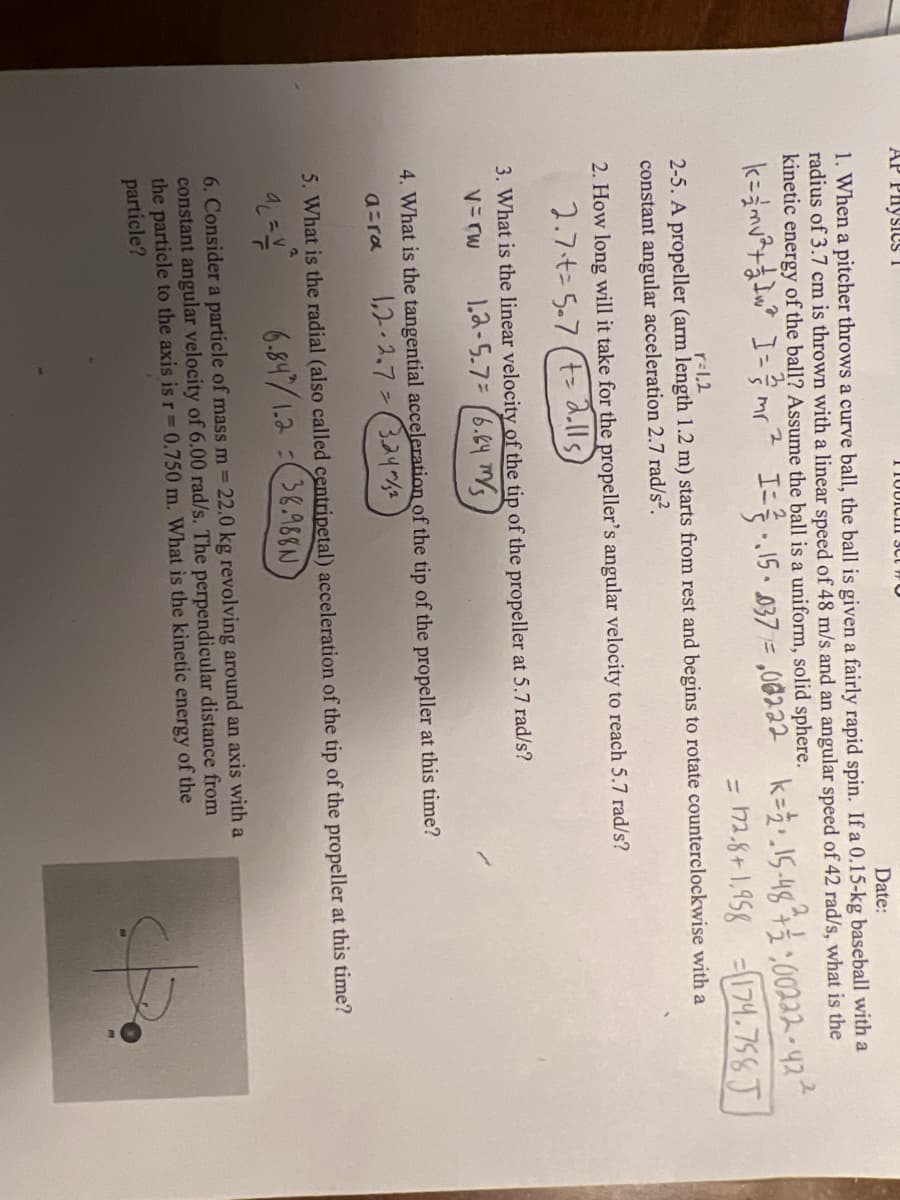1. When a pitcher throws a curve ball, the ball is given a fairly rapid spin. If a 0.15-kg baseball with a radius of 3.7 cm is thrown with a linear speed of 48 m/s and an angular speed of 42 rad/s, what is the kinetic energy of the ball? Assume the ball is a uniform, solid sphere. 2 k={/m² ² + 1 ² ] = ³/2mr ² 1=²..15.037 = .00222 k=15-48² +00222-421 = 172.8+1.958 = 174.758 J r=1.2 2-5. A propeller (arm length 1.2 m) starts from rest and begins to rotate counterclockwise with a constant angular acceleration 2.7 rad/s². 2. How long will it take for the propeller's angular velocity to reach 5.7 rad/s? 2.7-t=5.7 (t= 2.11s 3. What is the linear velocity of the tip of the propeller at 5.7 rad/s? v=rw 1.2-5.7= (6.84 m/s 4. What is the tangential acceleration of the tip of the propeller at this time? 1.2.2.7 = (3.24/2 a=ra 5. What is the radial (also called centripetal) acceleration of the tip of the propeller at this time? 2 9₁== 6.84/1.238.988N 6. Consider a particle of mass m = 22.0 kg revolving around an axis with a constant angular velocity of 6.00 rad/s. The perpendicular distance from the particle to the axis is r=0.750 m. What is the kinetic energy of the particle? 2
1. When a pitcher throws a curve ball, the ball is given a fairly rapid spin. If a 0.15-kg baseball with a radius of 3.7 cm is thrown with a linear speed of 48 m/s and an angular speed of 42 rad/s, what is the kinetic energy of the ball? Assume the ball is a uniform, solid sphere. 2 k={/m² ² + 1 ² ] = ³/2mr ² 1=²..15.037 = .00222 k=15-48² +00222-421 = 172.8+1.958 = 174.758 J r=1.2 2-5. A propeller (arm length 1.2 m) starts from rest and begins to rotate counterclockwise with a constant angular acceleration 2.7 rad/s². 2. How long will it take for the propeller's angular velocity to reach 5.7 rad/s? 2.7-t=5.7 (t= 2.11s 3. What is the linear velocity of the tip of the propeller at 5.7 rad/s? v=rw 1.2-5.7= (6.84 m/s 4. What is the tangential acceleration of the tip of the propeller at this time? 1.2.2.7 = (3.24/2 a=ra 5. What is the radial (also called centripetal) acceleration of the tip of the propeller at this time? 2 9₁== 6.84/1.238.988N 6. Consider a particle of mass m = 22.0 kg revolving around an axis with a constant angular velocity of 6.00 rad/s. The perpendicular distance from the particle to the axis is r=0.750 m. What is the kinetic energy of the particle? 2
Principles of Physics: A Calculus-Based Text
5th Edition
ISBN:9781133104261
Author:Raymond A. Serway, John W. Jewett
Publisher:Raymond A. Serway, John W. Jewett
Chapter10: Rotational Motion
Section: Chapter Questions
Problem 53P
Related questions
Question
Could you check my work from 1-5? I understand if you cannot do all questions, would just appreciate whatever you are allowed to do. Thanks!

Transcribed Image Text:AP Physics
Date:
1. When a pitcher throws a curve ball, the ball is given a fairly rapid spin. If a 0.15-kg baseball with a
radius of 3.7 cm is thrown with a linear speed of 48 m/s and an angular speed of 42 rad/s, what is the
kinetic energy of the ball? Assume the ball is a uniform, solid sphere.
1 ² mr²
k=1/√² + 1² =
²²2² =²..15. 037 = .00222 k = 1.15-48² +1 00222-42²
174.758J
= 172.8+1.958
TTouiem set
r=1.2
2-5. A propeller (arm length 1.2 m) starts from rest and begins to rotate counterclockwise with a
constant angular acceleration 2.7 rad/s².
A
2. How long will it take for the propeller's angular velocity to reach 5.7 rad/s?
2.7.t=5.7 (t = 2.115)
3. What is the linear velocity of the tip of the propeller at 5.7 rad/s?
V=rw
1.2-5.7= (6.84 m/s
4. What is the tangential acceleration of the tip of the propeller at this time?
b2-27 ay nga
a=ra
7
9₁ ====
5. What is the radial (also called centripetal) acceleration of the tip of the propeller at this time?
2
6.84/1.2 38.988N
6. Consider a particle of mass m = 22.0 kg revolving around an axis with a
constant angular velocity of 6.00 rad/s. The perpendicular distance from
the particle to the axis is r=0.750 m. What is the kinetic energy of the
particle?
P
Expert Solution
This question has been solved!
Explore an expertly crafted, step-by-step solution for a thorough understanding of key concepts.
This is a popular solution!
Trending now
This is a popular solution!
Step by step
Solved in 5 steps

Knowledge Booster
Learn more about
Need a deep-dive on the concept behind this application? Look no further. Learn more about this topic, physics and related others by exploring similar questions and additional content below.Recommended textbooks for you

Principles of Physics: A Calculus-Based Text
Physics
ISBN:
9781133104261
Author:
Raymond A. Serway, John W. Jewett
Publisher:
Cengage Learning

Physics for Scientists and Engineers with Modern …
Physics
ISBN:
9781337553292
Author:
Raymond A. Serway, John W. Jewett
Publisher:
Cengage Learning

Glencoe Physics: Principles and Problems, Student…
Physics
ISBN:
9780078807213
Author:
Paul W. Zitzewitz
Publisher:
Glencoe/McGraw-Hill

Principles of Physics: A Calculus-Based Text
Physics
ISBN:
9781133104261
Author:
Raymond A. Serway, John W. Jewett
Publisher:
Cengage Learning

Physics for Scientists and Engineers with Modern …
Physics
ISBN:
9781337553292
Author:
Raymond A. Serway, John W. Jewett
Publisher:
Cengage Learning

Glencoe Physics: Principles and Problems, Student…
Physics
ISBN:
9780078807213
Author:
Paul W. Zitzewitz
Publisher:
Glencoe/McGraw-Hill

University Physics Volume 1
Physics
ISBN:
9781938168277
Author:
William Moebs, Samuel J. Ling, Jeff Sanny
Publisher:
OpenStax - Rice University

Physics for Scientists and Engineers
Physics
ISBN:
9781337553278
Author:
Raymond A. Serway, John W. Jewett
Publisher:
Cengage Learning

Physics for Scientists and Engineers: Foundations…
Physics
ISBN:
9781133939146
Author:
Katz, Debora M.
Publisher:
Cengage Learning